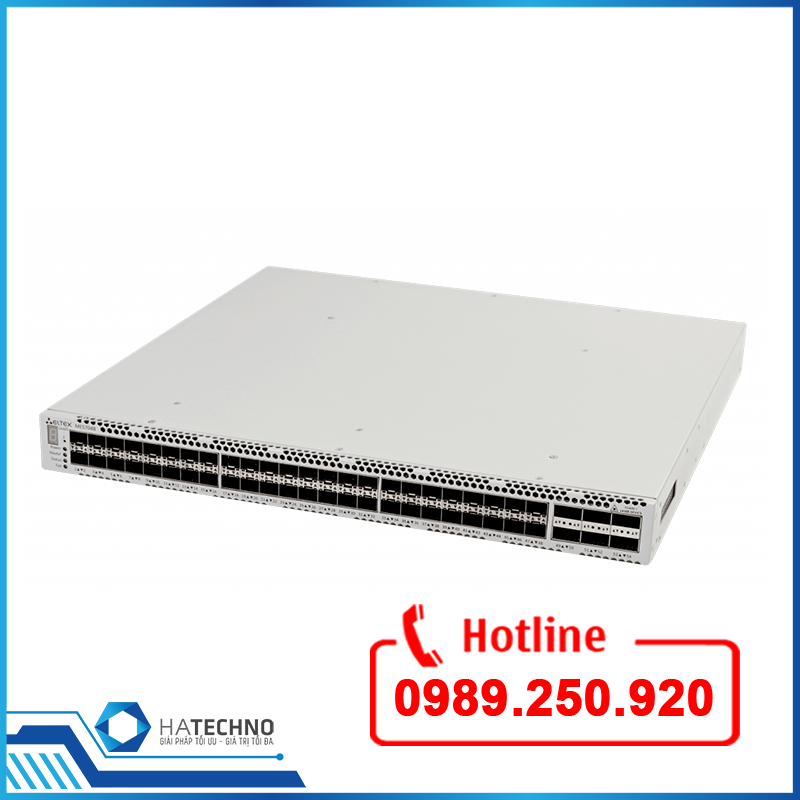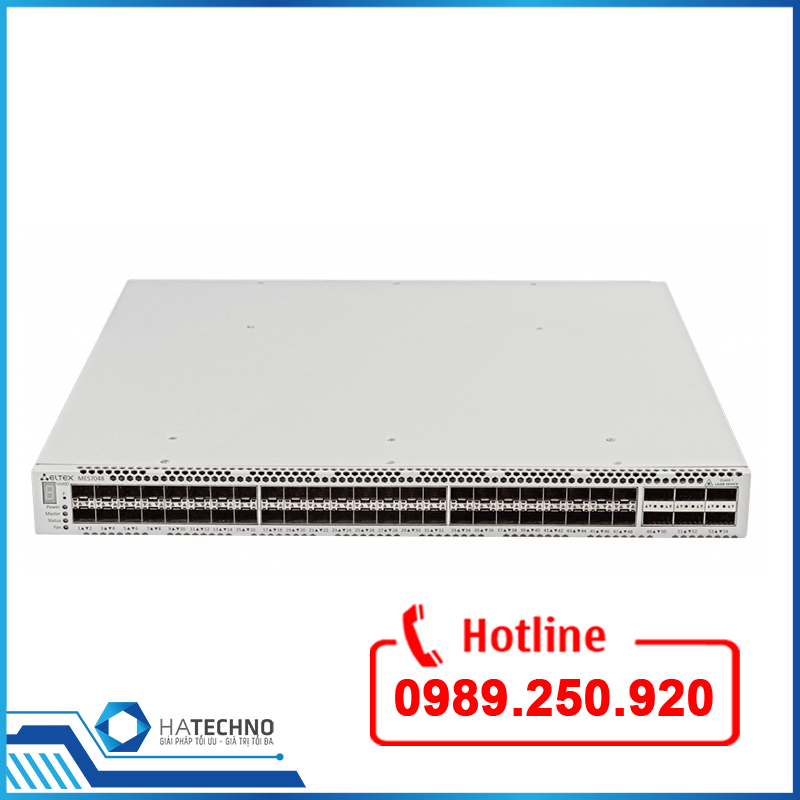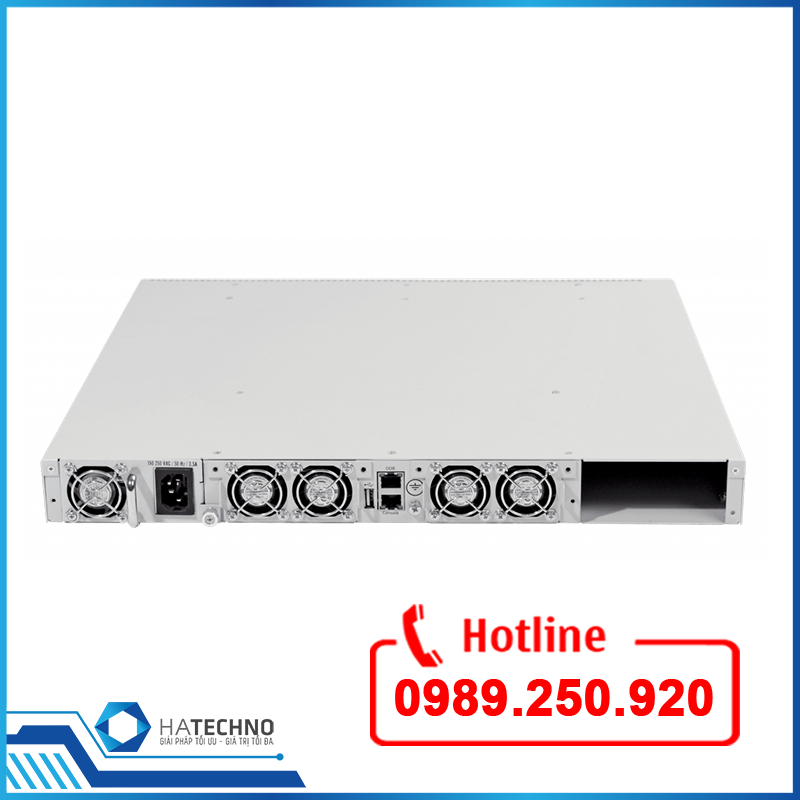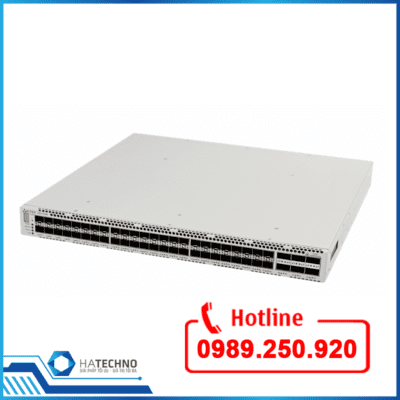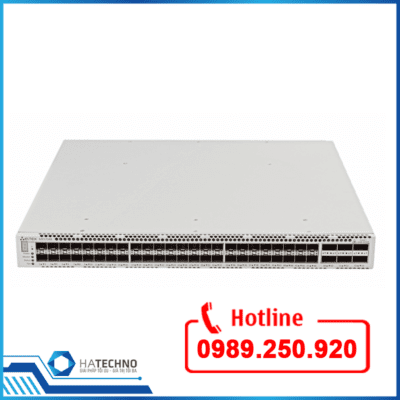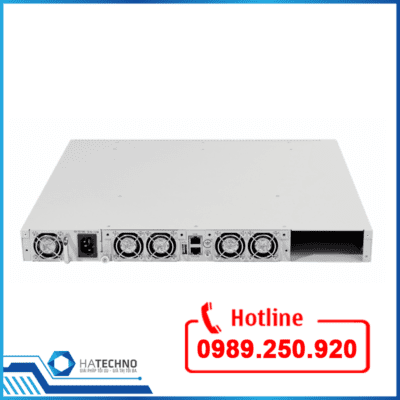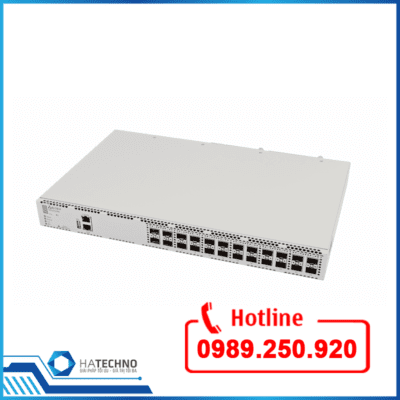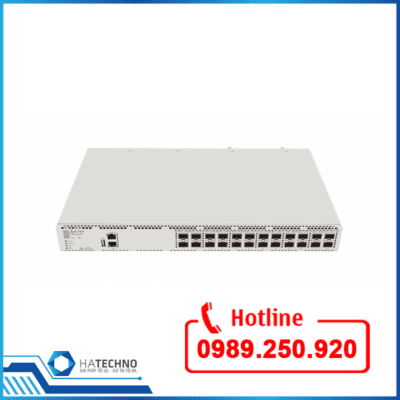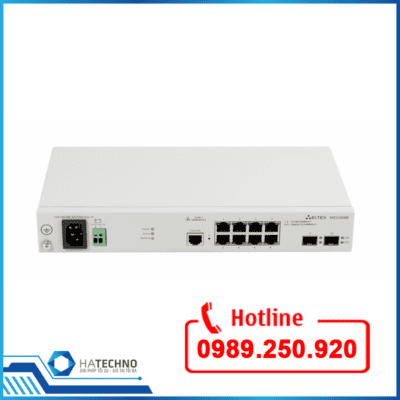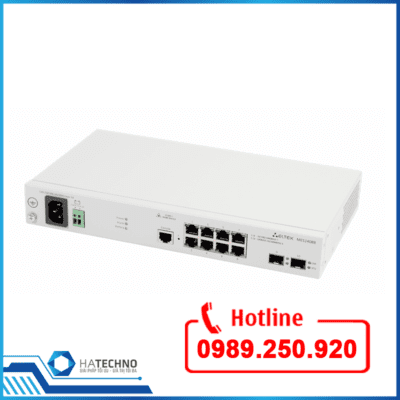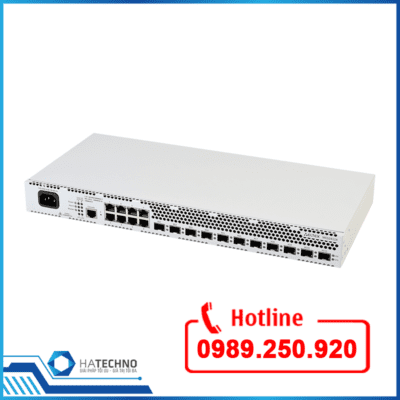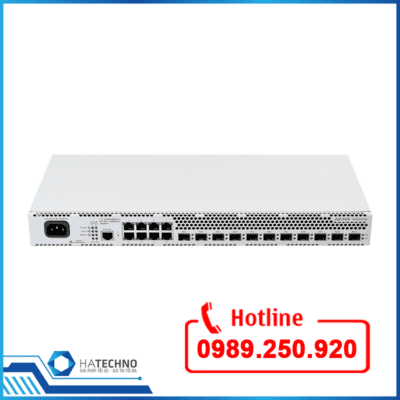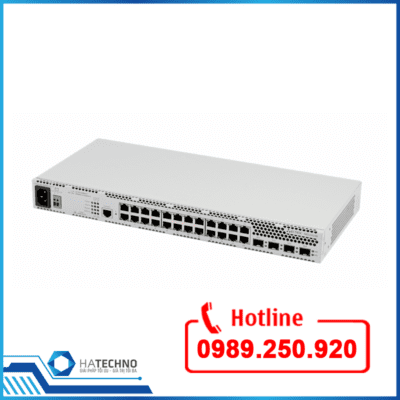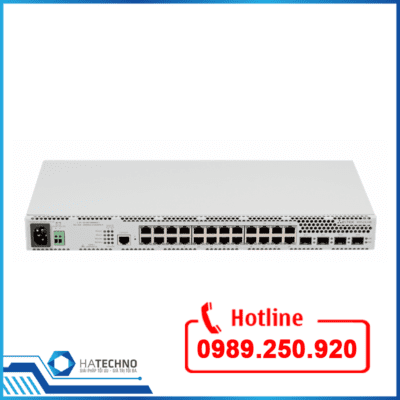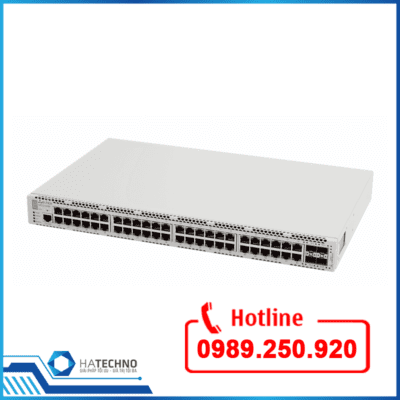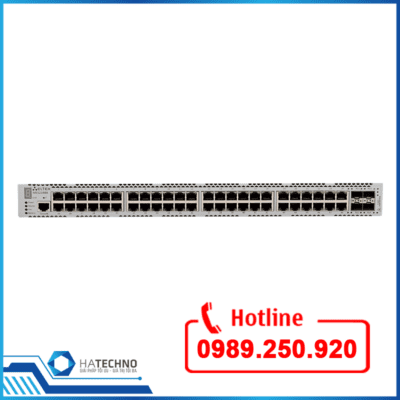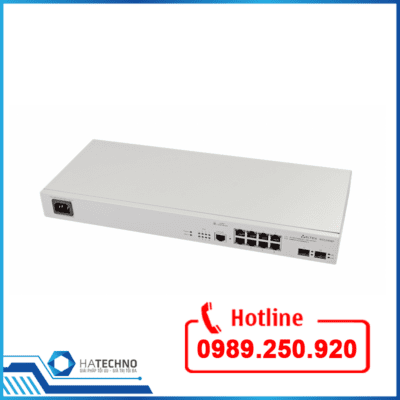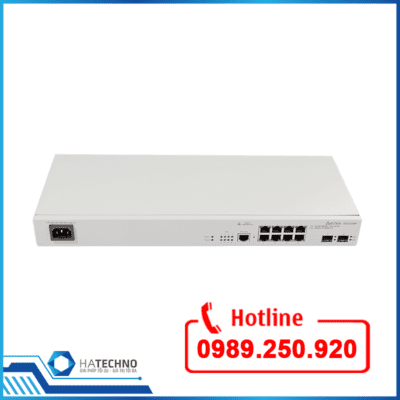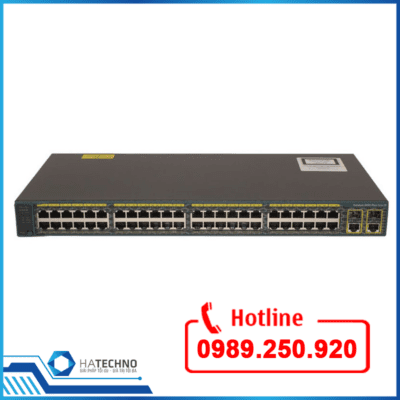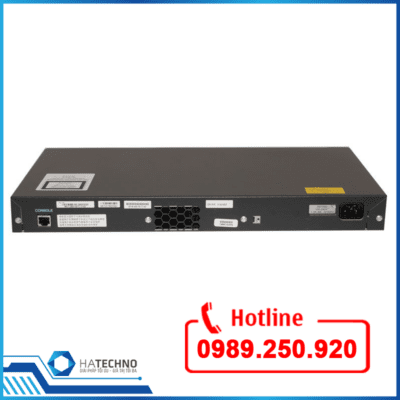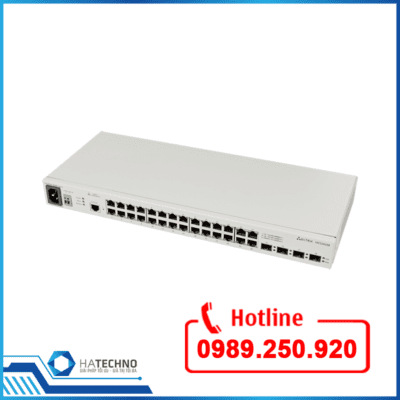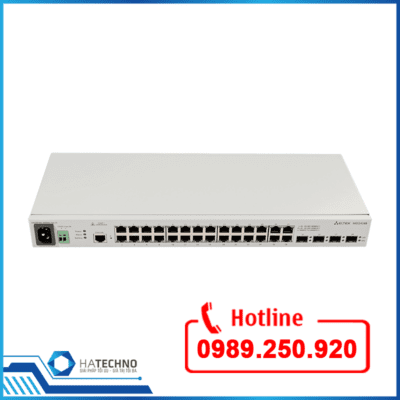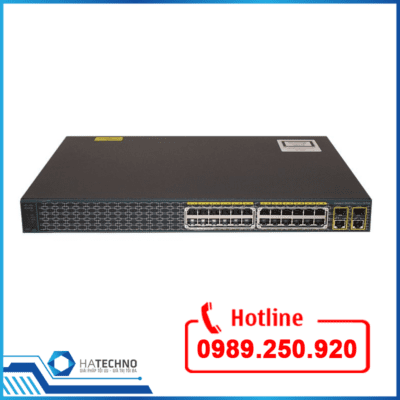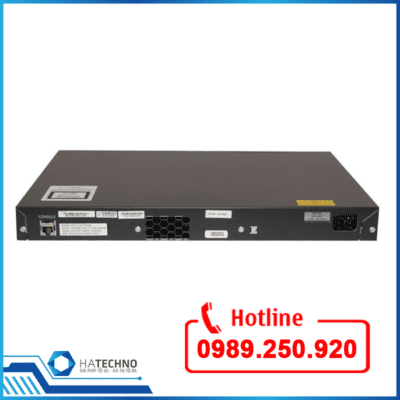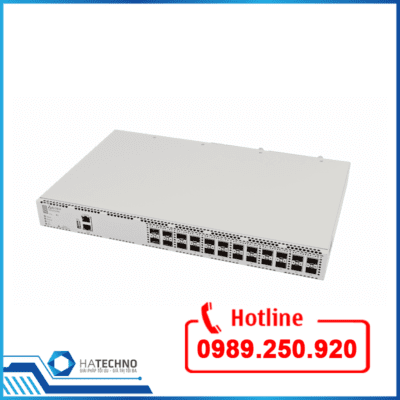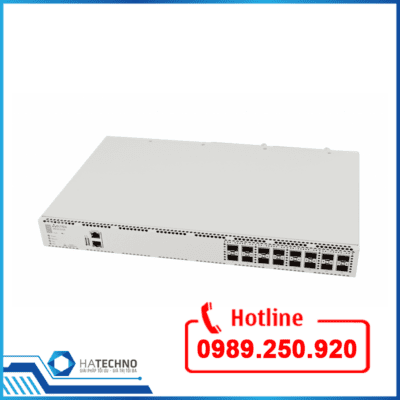Thiết bị chuyển mạch Eltex 10G/40G MES7048
(Chưa bao gồm VAT)
Ưu điểm chính:
- Bandwidth – 2.15 Tbps
- Non-blocking architecture
- L3 switch
- Stacking up to 8 devices
- 48 ports of 10G + ports of 100G
- MAC-table capacity – 294K
- Hot-swappable redundant power supplies
- Hot-swappable fans
- Front-to-Back cooling
Danh mục: Switch Eltex, Thiết Bị Mạng
5/5 - (1 bình chọn)
- Packet processor – Broadcom BCM56860 (Trident2+)
- CPU – Intel Atom C2558
Interfaces
- 10/100/1000BASE-T (OOB) – 1
- 10GBASE-R (SFP+) / 1000BASE-X (SFP) – 48
- 100GBASE-SR4/LR4(QSFP28) – 6
- USB – 1
- Console port – RS-232 (RJ-45)
Performance
- Bandwidth – 2.15 Tbps
- Throughput for 64 bytes1 – 1449 MPPS
- Buffer memory – 16 MB
- RAM (DDR3) – 4GB
- ROM (NAND) – 8GB
- MAC table – 294912
- ARP table – 6144
- VLAN table – 4094
- L2 Multicast groups – 2048
- 802.1ad rules (QinQ) – 4090
- ACL rules – 12276 Ingress, 1023 Egress
- IPv4 routes2 – 163813
- IPv6 routes2 – 81923
- VRRP routers – 20
- ECMP-groups – 512
- L3 interfaces – 256
- Link Aggregation Groups (LAG) – 64, 32 ports per LAG
- Loopback interfaces – 64
- Quality of Service (QoS) – 7 queues per port
- Jumbo frames size – 9394 bytes
- Stacking – up to 8 devices
Interface features
- Head-of-line blocking (HOL) protection
- Back Pressure
- Auto MDI/MDIX
- Jumbo Frames
- Flow Control (IEEE 802.3X)
- Protected ports
- Link Aggregation Groups (LAG)
- LACP
- Different LAG balancing algorithms
MAC table features
- MAC Multicast Support
- Static MAC filtering
- Port/VLAN MAC locking
VLAN features
- IEEE 802.1Q
- GVRP
- MAC/IP-based VLAN
- Different VLAN port operating modes
- Voice VLAN
- Independent VLAN learning
- Private VLAN
- Layer 2 Protocol Tunneling
L2 Multicast features
- IGMP Snooping v1,2,3
- Port/host-based IGMP Snooping Fast Leave
- MLD Snooping v1,2
- MGMD Snooping SSM
- IGMP and MLD Snooping Querier
- MVR
- GMRP
L3 functions
- Static routing
- Inter VLAN routing
- Dynamic routing protocols RIP, OSPFv2, OSPFv3, BGP
- Address Resolution Protocol (ARP)
- Proxy ARP
- VRF
- Policy-Based Routing
- BFD
- VRRP
- ECMP Load Balancing
- UDP Relay/IP Helper
- ICMP Throttling
- Loopback interfaces
- IPv6 Host
- IPv6 DHCP Client (Statefull/Stateless)
- DHCPv6 Server
- IPv4 and Ipv6
- ICMPv6 Throttling
Ring topology security functions
- STP (Spanning Tree Protocol, IEEE 802.1d)
- RSTP (Rapid Spanning Tree Protocol, IEEE 802.1w)
- MSTP (Multiple Spanning Tree Protocol, IEEE802.1s)
- PVSTP+ (Per VLAN Spanning Tree Protocol Plus)
- RPVSTP+ (Rapid Per VLAN Spanning Tree Protocol Plus)
- Spanning Tree Fast Link option
- STP Root Guard
- STP Loop Guard
- BPDU Filtering
- STP BPDU Guard
- Loopback Detection (LBD)
Security functions
- DHCP snooping (IPv4 and IPv6)
- IP source guard (IPv4 and IPv6)
- Dynamic ARP Inspection
- IPv6 RA Guard (Stateless)
- MAC-based authentication, Port Security, Static MAC entries
- Port-based authentication IEEE 802.1x
- Guest VLAN IEEE 802.1x
- DoS attack prevention
- Traffic segmentation
- Protection against non-authorized DHCP servers
- DHCP clients filtering
- BPDU attack prevention
- NetBIOS/NetBEUI filtering
Access Control Lists (ACL)
- L2-L3-L4 ACL
- Time-Based ACL
- IPv6 ACL
- ACL based on:
- Source/destination MAC/IP/IPv6 address
- Physical port number
- IEEE 802.1p
- VLAN ID
- EtherType
- TOS/DSCP/Preference
- Protocol type
- TCP/UDP source/destination port
- ACL actions:
- Egress queueing
- Flow-based redirecting and mirroring
- ACL-based fixed rate limiting
- Generation of trap log entries containing rule hit count
Quality of service (QoS)
- QoS statistics
- Shaping, policing
- IEEE 802.1p Class of Service (CoS)
- Interface trust mode: IEEE 802.1p, IP DSCP
- IEEE 802.1p and IP DSCP-based traffic classification and
- //mapping
- Storm control for various types of traffic (broadcast, multicast, unknown unicast)
- Interface bandwidth management
- Bandwidth management per queue
- Strict priority and weighted (WRR/WFQ) scheduling algorithms
- ACL-based CoS/DHCP mark assignment
- Tail Drop/Weighted Random Early Detection (WRED) queue //depth management
- Automatic VoIP Class of Service (CoS) settings
Management functions
- Configuration file download and upload via TFTP/SCP/FTP/SFTP //and USB
- Software file download and upload via TFTP/SCP/FTP/SFTP and //USB
- SNMP v1, v2, and v3
- Command Line Interface (CLI)
- SSH server
- Web interface
- NETCONF
- Syslog
- SNTP (Simple Network Time Protocol)
- Traceroute/Ping
- Authentication, Authorization and Accounting (AAA)
- Local authentication
- Command authorization
- RADIUS, TACACS+
- Management interface blocking
- SSL
- Macrocommands
- CLI command logging
- System log
- DHCP auto-provisioning
- Debugging commands
- CPU traffic limiting mechanism
- Command completion
- Context-sensitive help
- Password encryption
- Management access control lists
Monitoring functions
- Interface statistics
- Port mirroring (SPAN)
- Remote port mirroring (RSPAN)
- Remote monitoring (RMON/SMON)
- sFlow
- Task- and traffic type-based CPU utilization monitoring
- RAM utilization monitoring
- Temperature monitoring
- LLDP (802.1ab) + LLDP MED
- Virtual Cable Testing (VCT)
- Optical transceiver diagnostics
METRO
- Ethernet OAM
- IEEE 802.1ag Connectivity Fault Management (CFM)
- Unidirectional Link Detection (UDLD)
- Layer-2 Protocol Tunneling (L2PT)
- IEEE 802.1ad Double VLAN tagging (in compliance with TR-101)
Data Center Bridging (DCB)
- Quantized Congestion Notification (QCN)
- Enhanced Transmission Selection (ETS)
- Priority-Based Flow Control (PFC)
- Data Center Bridging Exchange Protocol (DCBX)– MLAG (Virtual Port Channel)
- FIP Snooping
- OpenFlow v1.0/v1.3.4
- Cut-through switching
Stacking
- Redundant Management Unit support
- Single IP address management
- Automatic election of management control unit
- Automatic software and configuration update throughout stack
- Hot-swap of stack units
- Offline configuration of stack units
- Stacking (up to 8 switches in a stack)
MIB/IETF
- IEEE 802.3 10BASE-T
- IEEE 802.3u 100BASE-T
- IEEE 802.3ab 1000BASE-T
- IEEE 802.3ac VLAN tagging
- IEEE 802.3ad Link aggregation
- IEEE 802.3ae 10GbE
- IEEE 802.3 Forward Error Correction (FEC) CL91
- IEEE 802.1ak Multiple Registration Protocol (MRP)
- IEEE 802.1as Timing and Synchronization for Time-Sensitive Applications in Bridged Local Area Networks
- IEEE 802.1s Multiple Spanning Tree compatibility
- IEEE 802.1w Rapid Spanning Tree compatibility
- IEEE 802.1D Spanning Tree Compatibility
- IEEE 802.1Q Virtual LANs with Port-based VLANs
- IEEE 802.1ad Double VLAN tagging (TR-101)
- IEEE 802.1ag Connectivity Fault Management (CFM)
- IEEE 802.3ah Operations, Administration and Maintenance
- (OAM)
- IEEE 802.1Qat Multiple Stream Reservation Protocol (MSRP)
- IEEE 802.1Qav Forwarding and Queuing Enhancements for Time-Sensitive Streams
- IEEE 801.1Qbb Priority-based Flow Control
- IEEE 802.1Qau Virtual bridged local area networks amendment 13: congestion notification (Draft 2.4)
- IEEE 802.1Qaz Enhanced transmission election for bandwidth sharing between traffic classes (Draft 2.4)
- IEEE 802.1v Protocol-based VLANs
- IEEE 802.1p Ethernet priority with user provisioning and mapping
- IEEE 802.1X Port-based authentication and supplicant support
- IEEE 802.3x Flow control
- IEEE 802.1AB Link Layer Discovery Protocol (LLDP)
- ANSI/TIA-1057 LLDP-Media Endpoint Discovery (MED)
- IEEE 1588v2 Precision Time Protocol (PTP)
- RFC 768 UDP
- RFC 783 TFTP
- RFC 791 IP
- RFC 792 ICMP
- RFC 793 TCP
- RFC 826 Ethernet ARP
- RFC 894 Transmissions of IP datagrams over Ethernet networks
- RFC 896 Congestion control in IP/TCP networks
- RFC 951 BootP
- RFC 1034 Domain names – concepts and facilities
- RFC 1035 Domain names – implementation and specification
- RFC 1321 Message digest algorithm
- RFC 1534 Interoperation between BootP and DHCP
- RFC 2021 Remote Network Monitoring Management
- //Information base v2
- RFC 2030 Simple Network Time Protocol (SNTP) v4 for IPv4, IPv6, and OSI
- RFC 2131 DHCP Client/Server
- RFC 2132 DHCP options and BootP vendor extension
- RFC 2347 TFTP option extension
- RFC 2348 TFTP block size option
- RFC 2819 Remote Network Monitoring Management Information Base
- RFC 2865 RADIUS client
- RFC 2866 RADIUS accounting
- RFC 2868 RADIUS attributes for tunnel protocol support
- RFC 2869 RADIUS Extensions
- RFC 3162 RADIUS and IPv6
- RFC 3164 The BSD syslog protocol
- RFC 3580 IEEE 802.1X RADIUS usage guidelines
- RFC 4541 IGMP Snooping and MLD Snooping
- RFC 5171 Unidirectional Link Detection (UDLD) Protocol
- RFC 5176 Dynamic Authorization Server
- RFC 5424 The Syslog Protocol
- RFC 1027 Using ARP to implement transparent subnet gateways (Proxy ARP)
- RFC 1256 ICMP router discovery messages
- RFC 1765 OSPF database overflow
- RFC 1812 Requirements for IP version 4 routers
- RFC 1997 BGP Communities Attribute
- RFC 2082 RIP-2 MD5 authentication
- RFC 2131 DHCP relay
- RFC 2328 OSPFv2
- RFC 2370 OSPF Opaque LSA Option
- RFC 2385 Protection of BGP Sessions via the TCP MD5 Signature Option
- RFC 2453 RIP v2
- RFC 2545 BGP-4 Multiprotocol Extensions for IPv6 Inter- Domain Routing
- RFC 2918 Route refresh capability for BGP-4
- RFC 3021 Using 31-Bit Prefixes on IPv4 Point-to-Point Links
- RFC 3046 DHCP/BootP relay
- RFC 3101 The OSPF “not so stubby area” (NSSA) option
- RFC 3137 OSPF stub router advertisement
- RFC 3623 Graceful OSPF restart-
- RFC 3704 Unicast Reverse Path Forwarding (uRPF)
- RFC 3768 Virtual Router Redundancy Protocol (VRRP) version 2
- RFC 5187 OSPFv3 Graceful Restart
- RFC 5340 OSPF for IPv6
- RFC 5549 Advertising IPv4 Network Layer Reachability Information with an IPv6 Next Hop
- RFC 5798 Virtual Router Redundancy Protocol (VRRP) version 3
- RFC 5880 Bidirectional Forwarding Detection
- RFC 5881 BFD for IPv4 and IPv6 (Single Hop)
- RFC 6860 Hiding Transit-Only Networks in OSPF
- RFC 1981 Path MTU for IPv6
- RFC 2460 IPv6 Protocol Specification
- RFC 2464 IPv6 over Ethernet
- RFC 2711 IPv6 Router Alert
- RFC 3056 Connection of IPv6 Domains via IPv4 Clouds
- RFC 3315 Dynamic Host Configuration Protocol for IPv6
- (DHCPv6)
- RFC 3484 Default Address Selection for IPv6
- RFC 3493 Basic Socket Interface for IPv6
- RFC 3513 Addressing Architecture for IPv6
- RFC 3542 Advanced Sockets API for IPv6
- RFC 3587 IPv6 Global Unicast Address Format
- RFC 3633 IPv6 Prefix Options for Dynamic Host Configuration Protocol (DHCP) version 6
- RFC 3736 Stateless DHCPv6
- RFC 4213 Basic Transition Mechanisms for IPv6
- RFC 4291 Addressing Architecture for IPv6
- RFC 4443 ICMPv6
- RFC 4861 Neighbor Discovery
- RFC 4862 Stateless Autoconfiguration
- RFC 6164 Using 127-bit IPv6 Prefixes on Inter-router Links
- RFC 6583 Operational Neighbor Discovery Problems
- RFC 854 Telnet
- RFC 855 Telnet Option Specifications
- RFC 1155 SMI v1
- RFC 1157 SNMP
- RFC 1212 Concise MIB definitions
- RFC 1867 HTML/2.0 forms with file upload extensions
- RFC 1901 Community-based SNMP v2
- RFC 1908 Coexistence between SNMP v1 and SNMP v2
- RFC 2068 HTTP/1.1 protocol as updated by draft-ietf-http-v11-spec-rev-03
- RFC 2271 SNMP Framework MIB
- RFC 2295 Transparent Content Negotiation
- RFC 2296 Remote Variant Selection; RSVA/1.0 State Management “Cookies”– draft-ietf-http-state-mgmt-05
- RFC 2576 Coexistence between SNMP v1, v2, and v3
- RFC 2578 SMI v2
- RFC 2579 Textual Conventions for SMI v2
- RFC 2580 Conformance statements for SMI v2
- RFC 2616 HTTP/1.1
- RFC 3410 Introduction and Applicability Statements for Internet Standard Management Framework
- RFC 3411 An Architecture for Describing SNMP Management Frameworks
- RFC 3412 Message Processing and Dispatching for SNMP
- RFC 3413 SNMP v3 Applications
- RFC 3414 User-Based Security Model for SNMP v3
- RFC 3415 View-Based Access Control Model for SNMP
- RFC 3416 Version 2 of the Protocol Operations for SNMP
- RFC 3417 Transport Mappings for SNMP
- RFC 3418 Management Information Base for SNMP
- RFC 6020 A Data Modeling Language for NETCONF
- RFC 6022 YANG Module for NETCONF Monitoring
- RFC 6242 Using the NETCONF Protocol over Secure Shell (SSH)
- RFC 6415 Web Host Metadata
- RFC 6536 NETCONF Access Control Model
- RFC 7223 YANG Data Model for Interface Management
- RFC 7277 YANG Data Model for IP Management
- RFC 7317 YANG Data Model for System Management
- RFC 2246: The TLS Protocol, version 1.0
- RFC 2818: HTTP over TLS
- RFC 3268: AES Cipher Suites for Transport Layer Security SSH 1.5 and 2.0
- RFC 4251: SSH Protocol Architecture
- RFC 4252: SSH Authentication Protocol
- RFC 4253: SSH Transport Layer Protocol
- RFC 4254: SSH Connection Protocol
- RFC 4716: SECSH Public Key File Format
- RFC 4419: Diffie-Hellman Group Exchange For The Ssh Transport Layer Protocol
- RFC 1858 Security Considerations for IP Fragment Filtering
- RFC 2474 Definition of the Differentiated Services Field (DS Field) in the IPv4 and IPv6 headers
- RFC 2475 An architecture for differentiated services
- RFC 2597 Assured forwarding Per Hop Behavior (PHB) group
- RFC 2697 Single-Rate Policing
- RFC 3246 An expedited forwarding PHB
- RFC 3260 New terminology and clarifications for DiffServ
- RFC 1997 BGP Communities Attribute
- RFC 2385 Protection of BGP Sessions via the TCP MD5 Signature Option
- RFC 2545 BGP-4 multiprotocol extensions for IPv6 inter-domain //routing
- RFC 2918 Route Refresh Capability for BGP-4
- RFC 4271 A Border Gateway Protocol 4 (BGP-4)
- RFC 4360 BGP Extended Communities Attribute
- RFC 4456 BGP Route Reflection: An Alternative to Full Mesh Internal BGP (IBGP)
- RFC 4486 Subcodes for BGP Cease Notification Message
- RFC 4724 Graceful Restart
- RFC 4760 Multiprotocol Extensions for BGP-4
- RFC 5492 Capabilities Advertisement with BGP-4
- RFC 6793 BGP Support for Four-Octet Autonomous System (AS) Number Space
- RFC 7047 Open vSwitch Database Management Protocol
- ANSI/INCITS Fibre Channel backbone-5 (FC-BB-5) Rev 2.0.0 – FIP Snooping bridge
- OpenFlow Switch Specification, Version 1.0.0 (Wire Protocol 0x01) и Version 1.3.4
Physical and environmental parameters
- Max. power consumption – 180 W
- Power supply:
- 176..264 V AC, 50 Hz
- 36..72 V DC
- Power supply options:
- 1 AC/DC power supply
- 2 hot-swappable AC/DC power supplies
- Operating temperature – from 0 to +45 0C
- Storage temperature – from -40 to +70 0C
- Operating humidity – 80%
- Cooling – Front-to-Back, 4 fans
- Implementation – 19″, 1U
- Dimensions (WxHxD) – 440x44x447 mm
- Weight – 6.35 kg
Sản phẩm tương tự
(Chưa bao gồm VAT)
(Chưa bao gồm VAT)
(Chưa bao gồm VAT)
(Chưa bao gồm VAT)
(Chưa bao gồm VAT)
(Chưa bao gồm VAT)
(Chưa bao gồm VAT)
New
(Chưa bao gồm VAT)
9,070,000₫ (Chưa bao gồm VAT)
(Chưa bao gồm VAT)

